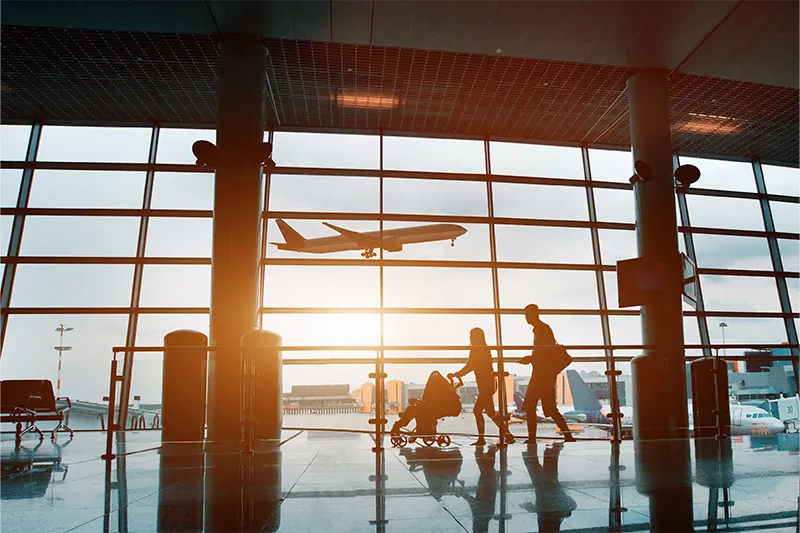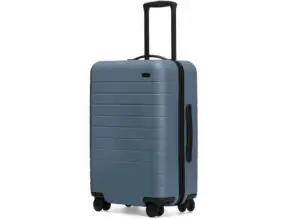Sometimes there is nothing you can do to avoid paying more than you’d like for airfare, but there are a few things you can try to keep from paying more than you should. To help you sidestep the most common errors that even sophisticated travelers make, here are seven flight booking mistakes to avoid before your next trip.

Don’t Forget About Alternate Airports
Many major cities have more than one good-sized airport, but by searching only on a specific one, you won’t see potentially better fares to other nearby gateways. A couple of classic U.S. examples are Newark vs. JFK vs. LaGuardia, or Long Beach vs. LAX; overseas a good example is Gatwick vs. Heathrow in London.
To get these airports into the mix, choose the “All Airports” option shown on many airline and flight booking sites that includes a city code instead of an airport code. So when traveling to or from New York, sites like Expedia allow you to use NYC instead of JFK or EWR, and will return fares from all area airports. In Los Angeles, the code for all airports is QLA (instead of the more limited LAX).
In the case of densely populated areas, you can sometimes fly into an entirely different city altogether. For example, San Diego is about a two-hour drive from Los Angeles (depending on traffic, of course); that makes it a somewhat reasonable alternative to Los Angeles, especially if your trip takes you to areas south of L.A. like Newport Beach, San Clemente, and the like. Similarly, Chicago and Milwaukee are about 90 miles apart, and Tampa and Orlando are separated by about 85 miles.
If your booking site does not allow this (for example, CheapFlights.com seems to accept NYC, but not QLA), or you’re not sure what your other options are, another way to discover nearby airports is to do a search on Kayak and use their filter options to include nearby airports with available routes. You can also consult this cool chart from Johnny Jet that lists nearby airports in the U.S. by miles from your departure or destination airport.
Don’t Forget to Try Searching on an Incognito Browser
It’s long been suspected that airlines and booking engines may show higher fares on routes that you have previously searched. If you are researching an upcoming trip from Chicago to Paris, for example, and have checked airfares on the route frequently in recent days or weeks, the site “knows” you really want these fares, and “guesses” that you might be willing to pay a bit more for them.
So, do flight prices go up the more you look at them? I have not been able to duplicate this myself, and the SmarterTravel team hasn’t found any evidence that airlines raise fares if you’ve previously searched for a given itinerary. A recent study found that fares do differ on occasion, but you’re actually more likely to see lower fares if you’re logged into a given booking site rather than searching on a browser with no previous history of researching that route.
Because of this uncertainty, it’s worth trying your search both ways—on your normal browser (preferably while logged into your favorite booking site) and on an incognito browser where your searches aren’t tracked.
Don’t Book on Days When Prices Are Higher
Unless you are booking travel for work, it is obviously most convenient to shop for and purchase airfares over the weekend, when you have more free time. However, Airfarewatchdog reports that many airlines release sales early in the week, making Tuesday and Wednesday a good time to catch low fares. FareCompare narrows it down even further, reporting that the best time to book U.S. domestic flights is Tuesday at 3 p.m. Eastern.
This varies somewhat for international flights, as might be expected with airlines based in a variety of countries with different fare updating patterns, so you will want to be a bit more vigilant for international fares. I recommend checking prices throughout the week or signing up for fare alerts from Airfarewatchdog.
Keep in mind, too, that prices for last-minute flights are almost always higher than those booked further in advance. You’re typically better off booking at least six weeks before a U.S. domestic flight, and even further in advance for international itineraries.

Don’t Fly on Friday or Sunday
Airlines tend to jack up airfares for Friday and Sunday flights for the simple reason that these are the most likely days leisure travelers and vacationers are going to travel. The number of travelers also gets pushed up on Fridays by business travelers racing home, so this can be a particularly pricey day. Mondays can also be pricey thanks to their popularity with business travelers.
The cheapest days to fly tend to be Tuesdays and Wednesdays, with Thursdays and Saturdays costing a little more. That means that if your departure or return flight falls on a Monday, Friday, or Sunday, you’re likely paying more than you need to. It may take some creative use of your vacation time—such as a trip that runs Tuesday to Tuesday rather than Sunday to Sunday—but what you lose in flexibility you more than make up for in savings.
Don’t Forget to Shop Around
Like a lot of us, over the years I have accumulated some booking engine loyalties, but they’re not strong enough to keep me from checking fares on multiple sites, especially as I get closer to making the actual booking. There are some great search engines out there that allow you to compare flight prices on multiple sites at once. But relying on any one of them alone would be a mistake. Each site employs slightly different search algorithms, and as a result can sometimes return different prices—and flight times and combinations as well, which certainly adds value.
A good starting point is our list of The Best Flight Search Sites for Booking Cheap Airfare. To make this easier and semi-automated, you may want to set up multiple email alerts, too. It can take significant time to check a whole heap of sites every day, but if you sign up for fare alerts, you’ll be notified when a price goes down.
And unless you’re aiming for elite status on a specific airline—which generally requires a minimum of 25,000 air miles flown per calendar year, as well as a minimum amount spent—it doesn’t make a lot of sense to base your purchasing decisions around loyalty to an airline or its frequent-flyer program. Shop around on all of the major online travel agencies (OTAs) and directly with the low-cost carriers (like Southwest) whose best fares are nowhere to be found on OTAs.
Don’t Book a Too-Tight Connection
Fifty minutes might seem like long enough to get from one gate to another on a domestic flight, but what happens if your first flight is delayed by half an hour? On international flights, have you allowed enough time to go through customs, reclaim your bags, and wait through another security line—even if your first flight doesn’t arrive on time?
Avoid booking domestic connections that are less than an hour, particularly if you know your connecting airport is large and has terminals spread out, or if you’re flying different legs on separate carriers that may not share gate areas and/or terminals. On international flights, allow at least two hours.

Don’t Ignore Other Costs, Both Human and Financial
Sometimes the money you save on a cheaper airfare is absorbed almost instantly by other expenses you incur. Make sure you check to see if the rates you’re excited about include all taxes and fees, including baggage fees for checked or even carry-on bags. For example, a $200 round-trip flight on American will cost you $240 if you check a bag. That same $200 flight on Southwest will cost you … $200.
Consider other sneaky travel expenses as well: the need to stay in an airport hotel for a really early flight, seat selection fees on a discount airline, or gas and tolls to a more distant airport. Other potential costs might include an extra day in a kennel for your pet or more expensive airport meals on the road when saving by booking connections.
You may also want to check whether one airline has better entertainment options, seatback screens vs. overhead (or none), a better seat layout, more legroom, or better meal service. Price aside, these are all factors that can make a big difference in how pleasant—or miserable—your flight might be.
A good friend recently booked his family on a very early flight out of San Antonio, and at around 7:00 a.m. posted a photo on Twitter of his bleary-eyed teenage daughter dragging herself through the airport. The caption: “Thank you to my daughter for getting up at 3:30 a.m. so we could save $30 on airfare.” Ouch.
4 Quick Bonus Flight Booking Mistakes to Avoid
- Don’t book a trip to the wrong airport. Make sure you know your airport codes; you don’t want to end up in South Dakota when you meant to go to Hawaii (it’s possible).
- Don’t dismiss the travel agent option—especially if you’ve got complicated, multi-stop flights. If you’ve got an agent you love and who loves you, you’ll quickly see the perks pile up.
- Don’t ignore any follow-up emails or calls from your travel provider. Be sure to update your spam filters to ensure these messages don’t end up in the trash folder. Otherwise, you might miss flight time changes or other important notifications.
- Don’t confuse direct and nonstop flights. A nonstop flight is exactly what it sounds like, while a direct flight may include a few stops along the way to drop off and pick up passengers. You may want to pay the extra fare to get the nonstop (read: faster) trip.
One Mistake That Could Work In Your Favor
We all make mistakes, and this applies to major airlines as well. Every so often, carriers accidentally publish fares much lower than the actual intended cost of the flight. If you can snag these ‘mistake fares’ while they’re still live, you could score an incredible deal. Rather than staying glued to the screen in hopes of coming across a mistake airfare by chance, there are multiple services that will send you automated emails when these fares are published. Check out our guide on How to Score Premium Airfare Deals to learn how to stay on top of the best fares for your flight.
Traveling? Aim for a Carry-On That Does MORE
Three words: lightweight, durable, & multi-functional. The Bigger Carry-On from Away makes traveling that much easier, especially with its removable, TSA-approved battery for your electronics.
This story was originally published in 2017. It has been updated to reflect the most current information. Heather Greenwood Davis, Sarah Pascarella, Josh Roberts, Sarah Schlichter, and Margaret Leahy also contributed to this story. Some of the links featured in this story are affiliate links, and SmarterTravel may collect a commission (at no cost to you) if you shop through them. As an Amazon Associate, we earn from qualifying purchases.
You Might Also Like:
• The Best Frequent Flier Programs for 2025• How to Stay Sane When Planning a Trip with Friends
• International Car Rental Tips You Need to Know
• 14 Tips for Choosing the Right Group Tour
• The Best Ways to Rack Up Airline Miles without Flying
We hand-pick everything we recommend and select items through testing and reviews. Some products are sent to us free of charge with no incentive to offer a favorable review. We offer our unbiased opinions and do not accept compensation to review products. All items are in stock and prices are accurate at the time of publication. If you buy something through our links, we may earn a commission.
Related
Top Fares From
Today's Top Travel Deals
Brought to you by ShermansTravel
Shop and Save with Country Inns...
Patricia Magaña
 Hotel & Lodging Deals
Hotel & Lodging Deals
$229 -- Chicago: Discounted Rates and...
Francesca Miele
 Hotel & Lodging Deals
$229+
Hotel & Lodging Deals
$229+
$188 -- Honolulu: Save on Oceanview...
Abigail Lamay
 Hotel & Lodging Deals
$188+
Hotel & Lodging Deals
$188+





